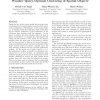Free Online Productivity Tools
i2Speak
i2Symbol
i2OCR
iTex2Img
iWeb2Print
iWeb2Shot
i2Type
iPdf2Split
iPdf2Merge
i2Bopomofo
i2Arabic
i2Style
i2Image
i2PDF
iLatex2Rtf
Sci2ools
PODS
1995
ACM
1995
ACM
Window Query-Optimal Clustering of Spatial Objects
During the last decade various spatial data structures have been designed and compared against each other with respect to their performance. Still missing is a lower bound result, e.g. an optimal spatial data clustering, which would allow for the absolute comparison of the performance of the well-known data structures with the optimum. In this paper, we address the static situation where the data is known in beforehand. An optimal data clustering for this setting will also provide a lower bound for the dynamic situation where the input data is not known in advance and the data structure is built up by iterated insertions. Using as performance measure the expected number of data bucket accesses needed to perform a window query, the static clustering problem turns into a classical optimization problem. For the special case of bucket capacity cb = 2 the optimization problem is solvable in polynomial time, whereas for cb 3 it is NP-hard. In experiments using simulated annealing heuristics...
| Added | 26 Aug 2010 |
| Updated | 26 Aug 2010 |
| Type | Conference |
| Year | 1995 |
| Where | PODS |
| Authors | Bernd-Uwe Pagel, Hans-Werner Six, Mario Winter |
Comments (0)

